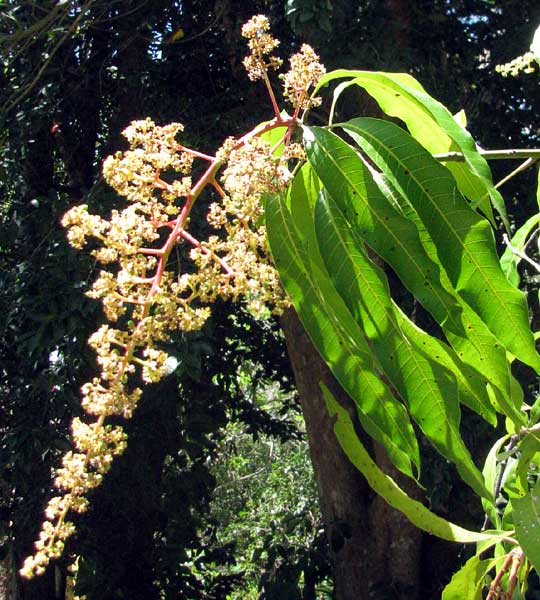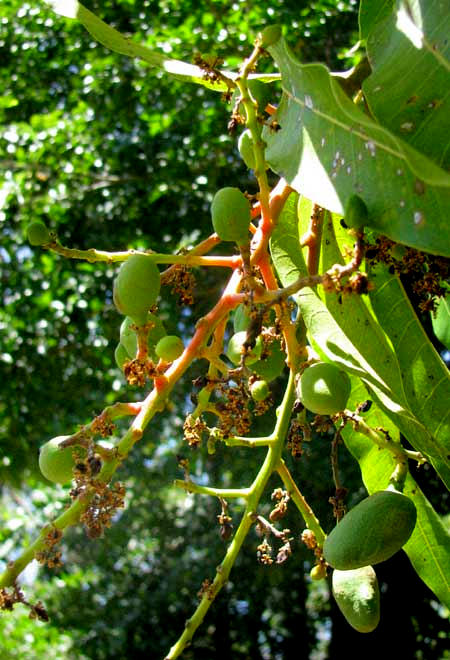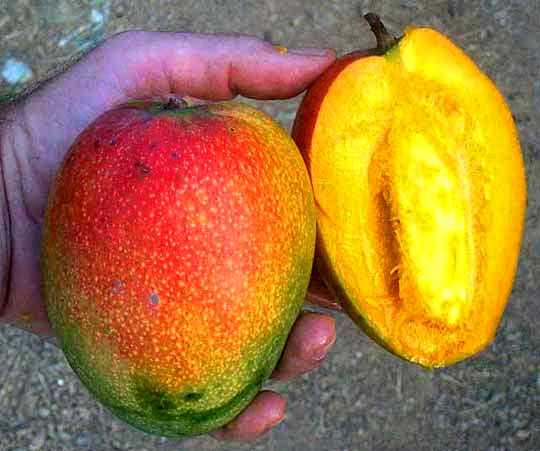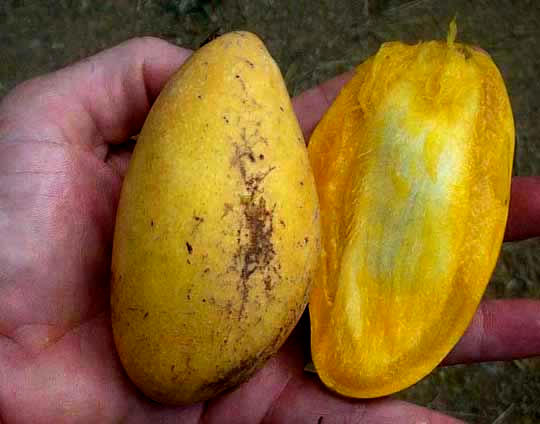Excerpts from Jim Conrad's
Naturalist Newsletter
from the April 11, 2010 Newsletter issued from Hacienda Chichen Resort beside Chichén Itzá Ruins, central Yucatán, MÉXICO
MANGO TREES FLOWERING
Some of our Mango trees, MANGIFERA INDICA, with their handsome, evergreen, 15-inch long (38 cm), dark-green, almost glossy, slender leaves, nowadays are abundantly mantled with foot-long panicles bearing hundreds of pale yellowish flowers on pink rachises, as shown below:

Mango trees are members of the Cashew Family, the Anacardiaceae, along with not only Cashews but also Pistachios, the sumacs, and Poison Oak and Poison Ivy. Flowers in the family typically bear 3-5 petals and have their ovaries perched atop "annular disks," which are doughnut-shaped things in the flower's center. Flowers can be unisexual or bisexual. Mango flowers display all those features but add some interesting innovations. You can see a small group of them below:

In that picture, look at the flower at the top, left. The green, spherical ovary -- the future mango -- is easy to make out, its slender style pointing skyward and ending with a tiny stigmatic area where pollen grains germinate. Mango ovaries are unusual in that their styles don't emerge from their centers, but rather a bit to one side. The resulting mango fruit will be a bit lopsided. Note that the green ovary rests atop a yellow, waxy/grainy-looking thing. That's the annular disk, in that flower so well developed that it appears to be oozing out between the five petal bases. The petals when fresh are white with little yellow ridges but in this more mature flower the ridges are turning brown.
Note behind that flower's ovary there's a single stamen, its dark purple, pollen-producing anther attached atop a pale, slender filament. Some mango flowers may have up to five stamens, but usually only one or two are fertile, the others hardly developed. Among all the flowers I examined on this tree I found only one stamen per flower. This is very unusual on flowers with such well developed petals and other parts.
Notice the younger flower at the lower right. That blossom is just like the top one, except that it contains no ovary at all. It's strictly a male, unisexual flower. The yellow glob in the center is the annular disk. The dark flower to the left of it is similarly a male, unisexual flower in which the stamen and annular disk have shriveled up. When a plant bears unisexual flowers mixed with flowers bearing both male and female parts, the plant is said to be polygamous.

Above you can see parts of two older panicles where most of the flowers have shriveled and fallen off or are in the process of doing so. Each panicle bears only a few maturing fruits. All the male flowers will shrivel and fall off, and the vast majority of female flowers with ovaries also will shrivel and fall. In the end, each panicle will bear only one or two fruits. In other words, by far most flowers with ovaries, even if they get pollinated, will abort, leaving only the strongest to mature into fruits.
from the July 20, 2007 Newsletter issued from from Sierra Gorda Biosphere Reserve, QUERÉTARO, MÉXICO
MANGO TREES FLUITING
I've been waiting for this. For weeks and weeks little green mangoes have been dangling from stocky, good-sized trees with dark green, evergreen leaves shaped like giant peach leaves. Slowly, slowly they've been growing. Below, you can see a couple of softball-size fruits currently on a neighbor's tree I pass each day:

Those fruits are still too green, only now beginning to show a hint of burgundy on their topsides. Look how they dangle on foot-long cords, which are what's left of the central axes of big flower-inflorescences. The flowers themselves were tiny, pinkish-white things bearing only a single fertile stamen per blossom and clearly few of the blossoms set fruit. Soon after flowering sometimes you could see several little fruits forming in the same inflorescence, but the weak ones aborted, falling off the tree, leaving the best to develop.
At http://www.fruitlovers.com/mangoposter.jpg you can see a colorful poster showing 143 distinct named mango varieties. The variety names are provided at http://www.fruitlovers.com/mangonames.html.
I just got back from the market with a bagful of mangoes and you can see a couple of those below:

I'm told that the ones in the above picture, probably the same kind hanging on our neighbor's trees, are the Kent variety. Notice the big, flattish, white seed in the fruit's center. Nowadays all over town you see these seeds discarded by mango eaters. Before long the furry, sun-bleached seeds will mount up in gutters like so many fast-breeding albino cockroaches.
In the above picture do you see the fibers arising from the seed's edge? Those fibers keep you from biting into a mango the way you would a peach. If you try to eat them peach-like, you'll end up picking fibers from between your teeth. If you cut mango flesh from its seed, then fibers are no issue.
Botanically there's something weird about those seeds. Each seed usually contains several embryos, and any embryo can make a tree. Usually only one of those embryos has resulted from fertilization. All the others are asexual, possessing exactly the same genetic makeup as the mother tree. People who grow mango trees on a large scale know to choose their seeds from superior trees, then destroy the sexual embryo while encouraging an asexual embryo to sprout. You don't want the sexual embryo because you never know what the pollen provider was like. In this way a whole plantation can be populated by genetically identical trees, all from a single superior mother tree. A document in PDF format showing a seed with multiple embryos and much more resides at http://www.agroforestry.net/images/pdfs/Mangifera-mango.pdf.
Most people around here say that the smaller Manila variety is better than my Kent. You can see Manilas below:

Nowadays you can buy a bag of six to eight perfect Manilas for about 90 cents US. As more trees ripen the price falls. When the rainy season really gets into gear little white worms will begin appearing in the fruits and the price will drop more. I remember times when I was low on dough but could buy an inordinate number of sublimely sweet mangoes, a few jalapeños and a kilo of freshly made, still-hot tortillas, and banquet like a king.
By the way, mangoes are the fruits of MANGIFERA INDICA, native to northern India, Burma and Malaya, and are members of the Cashew Family, in which we also find Pistachio, sumacs, and Poison Oak and Poison Ivy! With that pedigree I wouldn't be surprised if some people show an allergic reaction to mangoes. Happily, not me.